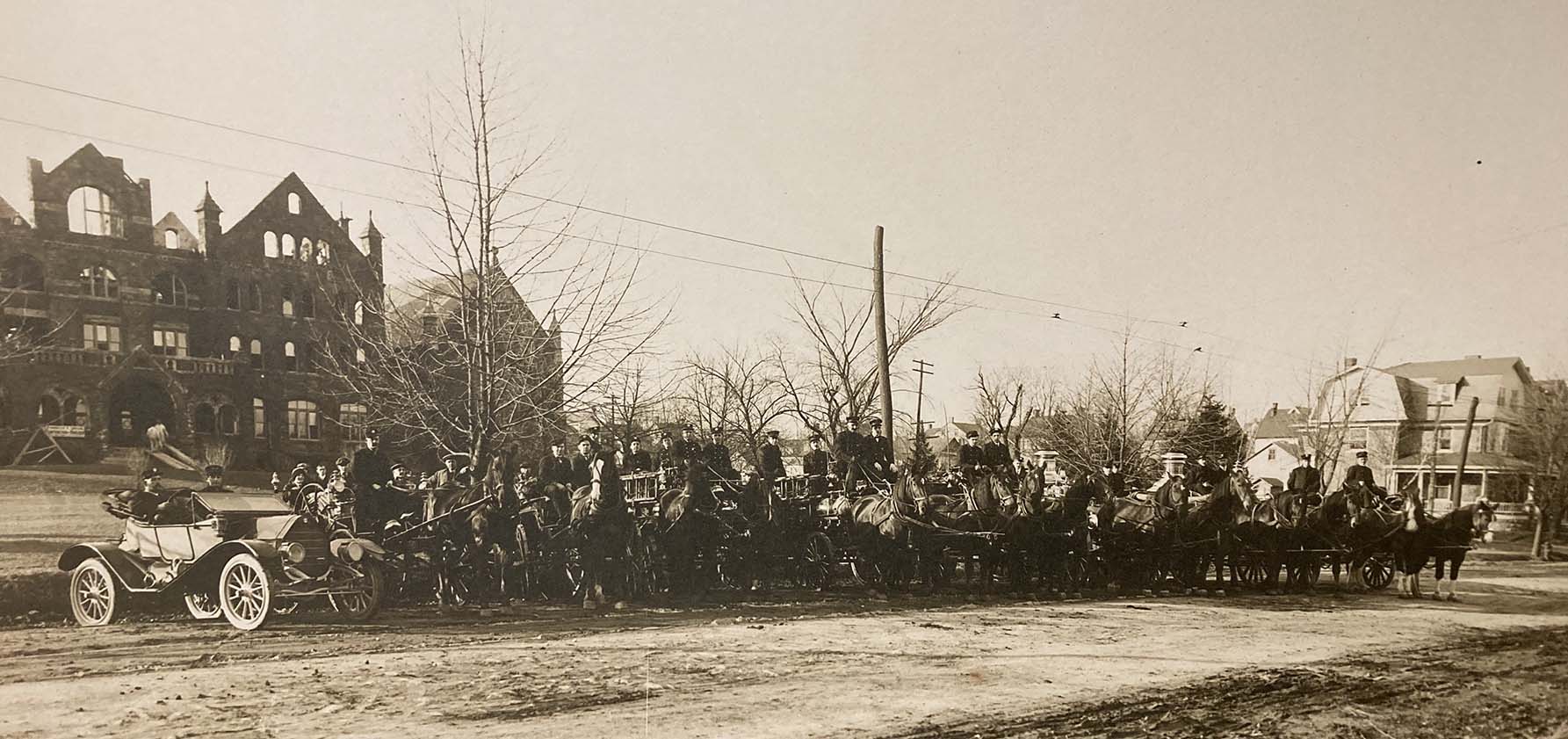
It was a Friday night, October 31, 1913, and Ernest Hagen was recuperating from an illness in his dorm room on the fourth floor of Comenius Hall at Moravian College and Theological Seminary. Most of the 60 or so other college and seminary students—all men at that time—who roomed in Comenius were elsewhere that evening, either attending Halloween parties or rehearsing for the annual school play. About 8:45 p.m., Hagen smelled smoke. When he went to investigate, he discovered flames emerging from the door of the elevator shaft on the second floor.
Hagen immediately called in an alarm to the Bethlehem Fire Department; meanwhile, other students who had remained on campus attempted to fight the flames using the building’s fire hoses. The students were able to quench the fire in the lower part of the elevator shaft (which may have saved the first floor of the building), but the hoses proved too short to reach the fourth floor, and water pressure wasn’t sufficient to be effective. By the time volunteer firefighters from Bethlehem had galloped up College Hill with their horse-drawn apparatus, the fire had spread to encompass the top two floors of the building.
The entire Bethlehem Fire Department, joined by several volunteer companies from South Bethlehem (then a separate borough), worked past midnight to subdue the flames, taking special care to prevent them from spreading to the Helen Stadiger Borhek Memorial Chapel in the north wing and the Harvey Memorial Library in the south wing. Fortunately, the Harvey library—the institution’s main library at the time—was connected to the central structure only on the first floor. Aided by a growing crowd of horrified townspeople, students carried most of the library’s furniture and valuable books across campus to the gymnasium in what is now Monocacy Hall. Thanks to their efforts, the only losses to the library were a few broken windows and a water-damaged floor. And thanks to the firefighters, the chapel was spared any damage at all.
The central section of Comenius Hall would not be so lucky. Sometime during the night, the roof collapsed “with an accompanying shower of sparks and a glare that lighted up the heavens for miles around,” reported the Allentown Democrat newspaper.
November 1, 1913, dawned on a blackened, hollow shell where the center of Moravian’s campus life had once stood. The second, third, and fourth floors of the central section were gone, along with the books, clothing, and personal possessions of most of the resident students, who were left with nothing but the clothes on their backs. Amazingly, aside from water damage to floors and woodwork, the first floor survived relatively intact. The loss to Moravian was estimated at $50,000 ($1.38 million in 2021 dollars)—only one-third of which was covered by insurance, according to The Comenian.
The fire had also taken a human toll. Moravian student Vaclav Vancura received an ugly gash on his hand and was overcome by smoke while trying to reach Ernest Hagen, whom he knew to be in the building. Several other students and firefighters suffered from smoke inhalation. John Fetter, assistant chief of the Bethlehem Fire Department, fell 12 feet from a ladder, spraining his back and ankle and receiving cuts on his hands and face from falling glass. Three other firefighters suffered minor to serious injuries.
Out of this tragedy, however, soon came rays of hope. The Moravian community and the Bethlehem community at large responded generously with offers of housing for displaced students, and within a few weeks, fundraising campaigns had brought in about $2,600 to replace students’ books and personal effects.
Students adapted to their change in circumstances. Each morning, they met in makeshift classrooms in the library, gymnasium, Borhek Chapel, and Laurel Street Chapel (which later became College Hill Moravian Church). Each afternoon, they helped carry furniture and books back to the library and get that building and Comenius Hall into working order. The college freshmen and sophomores, along with several seminary students, were temporarily quartered in a rented house, while the juniors and seniors took over the second floor of the library and the remaining seminarians occupied the infirmary.
By March 1914, donations from Moravian congregations throughout the country, alumni, and the Bethlehem community had supplied two-thirds of the estimated $60,000 needed to rebuild Comenius Hall to a stronger and more fire-resistant edifice than the 1893 original. Brick partition walls that had previously only extended to the ground floor were continued up to the fourth floor, forming compartments for each of the rooms below the fourth story and thus making it harder for flames to spread between rooms. Steel beams were added to strengthen the walls and roof. Wooden stairways were also replaced with steel ones, anchored to the brick walls, making the stairways less likely to drop in case of fire.